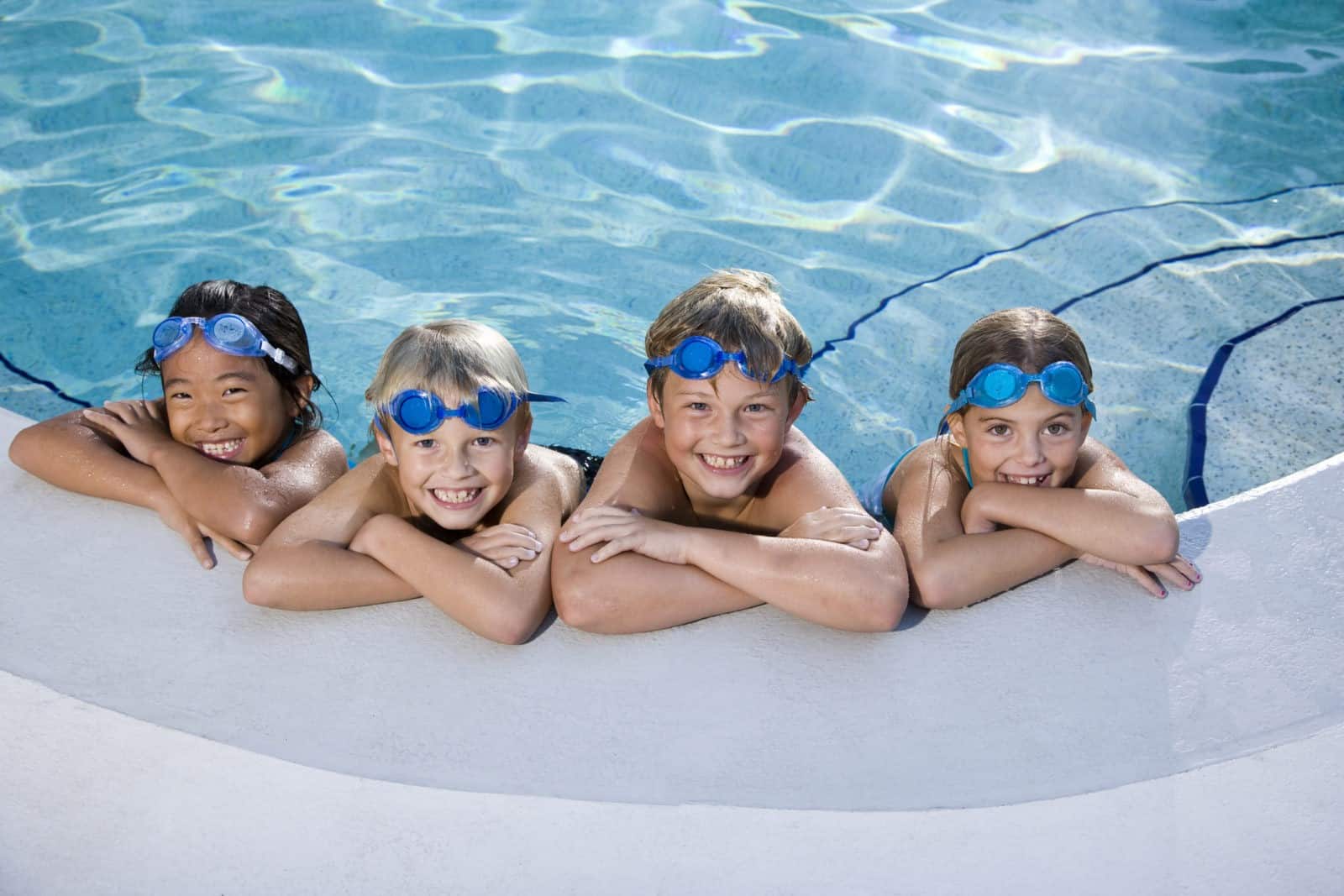Living in Florida, almost every day, my son asks if we can go to the beach or the pool. Since I also love the water, we go often but I’m always aware that drowning is the second most frequent cause of death for children up to age 14*.
To help keep my son safe in the water, I follow these 5 behaviors:
- Swim in designated areas with lifeguards
- Wear life jackets
- Do not get distracted or drink when supervising children
- Be a strong swimmer and teach children to swim
- Be aware of the weather (thunderstorms) and use sunscreen
Although this article doesn’t cover all aspects of being safe in the water, these tips can provide a safer, more enjoyable time at the river, lake, beach, or swimming pool.
1. Respect Life Guards and Aquatic Life.
Whether at the beach, visiting a lake, or heading to our community pool, we always swim in designated areas with lifeguards. Lifeguards are employed on a 1:100 ratio and this is based on the expectation that parents or nannies will provide direct supervision of their children. Children under 10 years old must be accompanied and constantly supervised by a parent or caregiver over 16 years of age.
It’s important to follow all lifeguard instructions as well as flag warnings. Different beaches and states have different colored flags and assigned meanings, so be sure to ask the lifeguard if you’re not sure what the flags signify. In general, red flags indicated the beach may be closed or there is a high hazard caused by surf or strong currents. Yellow flags indicate a moderate hazard and that waters may be rough and care should be taken if you are not a strong swimmer. Green means low hazard with calm conditions but be aware that currents will naturally push you down the shore. A purple flag indicates there is potentially dangerous marine life such as jellyfish which have been spotted in the area. Please leave animals alone including sea stars, sand dollars, and animals in sea shells. When handled by humans, even when handled gently, these delicate animals are often so severely injured, the interaction leads to their death.
2. Wear Life Jackets.
It is important to Invest in proper-fitting, Coast Guard-approved personal flotation devices or PFD’s which are also called life vests or life jackets. Since infants and children come in many sizes and shapes, the U.S. Coast Guard and personal flotation device (PFD) manufacturers urge that PFDs be tested immediately after purchase. Check the PFD for the proper weight range, comfortable fit, and especially a stable face-up position in water. You should test your PFD in a swimming pool and test it with the infant or child who will be wearing the PFD. To check for a good fit, pick the child up by the shoulders of the PFD. If the PFD fits right, the child’s chin and ears will not slip through. Some infants and children float best in one style of vest, while others will float better in another. To work as designed, a PFD must fit snugly on a child. Parents and care givers should remember that inflatable toys and rafts should not be used in place of life jackets.
3. No Distractions or Alcohol.
Drowning can happen quickly and quietly anywhere there is water including in the presence of lifeguards. Thus, it’s important to make sure at least one person is fully dedicated to watching children in the water. When tasked with this responsibility, you must keep focused and not get distracted. Cell phones should be put away, ear buds should be taken out or the speaker volume for music should be set to low. Conversations with others should allow for your focus to be on the children with your chair or standing position such that you can see the children at all times. If children are not wearing a life jacket, you should be in the water with the children, no more than arm’s length away. It’s easy to get distracted with a quick call or searching for a snack in a beach or pool bag but these can be the precious seconds or minutes when your attention is needed to save a child who needs helps in the water. Remember that you are responsible for the safety of children in your care, even if there are lifeguards. Adults often enjoy the summertime and water sports with alcoholic beverages including beer, wine, and liquors. For everyone’s safety, avoid drinking alcohol before or during swimming, boating, water skiing, and other water sports. Do not drink alcohol while supervising children as alcohol reduces balance, coordination, and judgment, and its effects are heightened by sun exposure and heat.
4. Know and Teach Swimming Skills.
Teaching children to swim can be a fun activity for both adults and children. Children ages 2 to 4 years old are coordinated enough to begin learning to swim. Kids under 4 years old and who do not know how to swim should wear a life jacket, even in the pool. Kids over 4 years old should take swimming lessons. As children learn water skills, remember that they are not yet strong or independent swimmers and still require full supervision. Don’t assume that a child who knows how to swim isn’t at risk for drowning. All kids need to be supervised in the water, no matter what their swimming skills.
5. Weather (Thunderstorms) and Use Sunscreen.
When planning a day of fun on the water, it’s important to check the weather conditions and use sunscreen. Adverse weather includes a high heat index or thunderstorms as they may impact water activities. As a storm or thunderstorm approaches, pools and other activities should be stopped and the water evacuated when there is a threat of a lightning strike.
Just one blistering sunburn in childhood or adolescence more than doubles a person’s chance for developing melanoma, or skin cancer later in life. Racking up more than five sunburns at any age also doubles the risk. Thus, it’s important to keep sunburns away by using a broad-spectrum sunscreen that protects against UVA and UVB with an SPF 15 or higher. SPF stands for the sun protection factor and is an indication of sunscreen effectiveness at preventing sunburn. Infants under 6 months of age should be kept out of the sun as their skin is too sensitive for sunscreen. An infant’s skin possesses little melanin, the pigment that gives color to skin, hair, and eyes and provides some sun protection. Therefore, babies are especially susceptible to the sun’s damaging effects.
For older children, sunscreen should be applied generously 30 minutes before going outdoors so the skin has time to absorb it. Don’t forget to protect ears, noses, lips, and the tops of feet. Take sunscreen with you to reapply during the day, especially after the child swims or exercises. This also applies to waterproof and water-resistant products. Sunscreen should be reapplied per the directions but at least every 2 hours and as often as every 90 minutes for children who are more susceptible to sunburns.
Water play is an important part of summer fun, so enjoy the local pool or head to the beach! To learn more water safety tips, enroll in the Water Awareness course offered in the Basic Nanny certification program by the Nanny Institute at USNannyInstitute.com.
 About the Author. Elizabeth Malson is a Certified Emergency First Responder Instructor and Master Scuba Diver Trainer. Elizabeth is also an adjunct faculty member of the US Nanny Institute, an organization dedicated to professional training and certification of elite Nannies and Sitters.
About the Author. Elizabeth Malson is a Certified Emergency First Responder Instructor and Master Scuba Diver Trainer. Elizabeth is also an adjunct faculty member of the US Nanny Institute, an organization dedicated to professional training and certification of elite Nannies and Sitters.
*Reference: Centers for Disease Control and Prevention, National Center for Injury Prevention and Control. Web-based Injury Statistics Query and Reporting System (WISQARS) [online]. [cited 2017 June 24]. Available from URL: http://www.cdc.gov/injury/wisqars.


Recent Comments